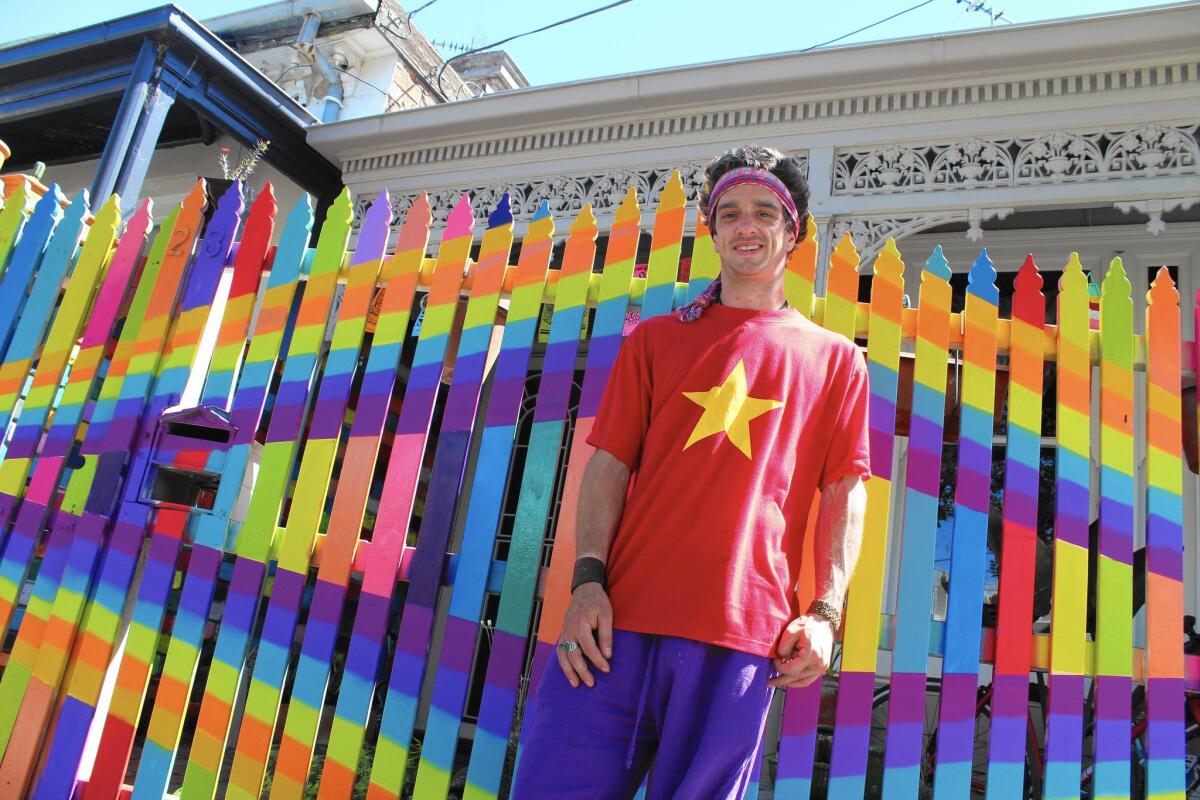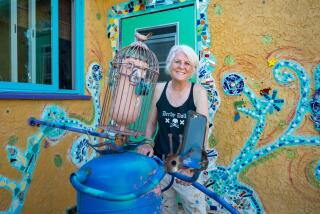Australian’s rainbow fence has officials seeing red, orange, yellow...

- Share via
Reporting from Melbourne, Australia — Wooden pickets of white, cream, beige, brown, gray and black stand guard over a sun-baked streetscape of bland fences and facades in suburban Port Melbourne.
Then there’s 23 Raglan St. The owner, Alex Skopellos, painted his pickets the colors of the rainbow, sparking a continuing, two-year battle with municipal authorities, threats of $3,820 in fines and legal fees, and a cat-and-mouse game with bureaucrats.
Last month, the municipal council offered Skopellos the choice of a palate of “heritage” colors and ordered him to repaint his fence. The 29-year-old chef, whose favorite color is purple, reacted with dismay.
“There were lots of different shades of white. About the closest thing to yellow was beige,” he lamented.
The fence war is reminiscent of a time, half a century ago, when painting a suburban Melbourne house an unusual color was considered almost un-Australian.
Back then, new owners of neglected Victorian-era terrace houses, many of them migrants from Southern and Eastern Europe, occasionally opted for sunshine yellow, pistachio green, strawberry pink or Mediterranean aqua, provoking sniffs of disapproval from the conservative locals.
Even at school, a strict teacher once interrogated our third-grade class on the colors that houses were painted. Hands shot up. He approved suggestions like tan, black, white, brown, gray and olive green.
But my answer, blue, raised eyebrows.
“Blue?” Could you paint a house blue, the teacher asked doubtfully. Heads shook back and forth. The consensus was, no, a house could not be blue.
My parents’ house — made of steel, with a flat roof, painted Bondi blue, designed by a prominent local architect — was the eccentric in a street of cream brick veneer and white weatherboard, all with cross-hipped pointy roofs.
Years later, in a nearby neighborhood, Skopellos rebelled even as a youngster, insisting that his bedroom walls be painted red, blue, green and purple with a yellow ceiling. It was like being inside a Rubik’s Cube.
“When I had my first bedroom, I said, ‘White, no way.’ To be honest from the age that I was 9, I wore very colorful, odd clothes. It’s not because I saw anyone else do it. I like color. I was born liking color. I’ve never worn black.”
His father, a toolmaker in the General Motors car factory who had immigrated from Greece and bought a home in Albert Park for $80,000, agreed to his son’s bedroom request, while keeping the picket fence dark green.
In a sign of urban gentrification, Skopellos’ father sold the domicile about two years ago for $2.1 million. Given some of the proceeds, the younger Skopellos bought his house in Port Melbourne, where the inflow of wealth and young professionals has been accompanied by heightened concern for the neighborhood’s heritage (and, Skopellos believes, property values).
“Port Melbourne used to be a really dodgy area. Now, it’s really trendy. It’s full of yuppies in apartments and soccer moms. The image of it is the conservative pretty area,” Skopellos said.
According to the municipal council, his Technicolor fence and adjacent multicolored brick wall have caused complaints, earning him a series of legal warnings and summonses to meetings with bureaucrats.
“Heritage is a very important issue to a number of people in the area and we have regulations,” Mayor Amanda Stevens told local news media. She said the suburb’s character was protected by regulations, including rules on external paint colors.
Skopellos does not carry a cellphone and is loath to make appointments, lest he interrupt his flow of inner spontaneity. Pinning him down can be a little difficult.
But when I finally do manage it, he sits beneath a garish, exhilarating mural covering almost all of his living room wall. He wears purple flowing trousers, a red T-shirt with a yellow star and a multicolor headband.
Bright flags with words such as “peace” and “love” flap at the front door, cactuses sprout from pots and incense wafts along the hallway. The wall outside his back window is painted with green and black loops like something from a kid’s sci-fi comic book.
Skopellos compares his palette to that of everyday folks in the colorful Buenos Aires suburb of La Boca, where he went on his first overseas trip.
“Practically every house is painted different colors. It’s very hard to find black or gray or white or even bland colors. It’s beautiful. It’s sunny. You are walking down the street, it just makes you feel better. There’s this fresh energy.”
Port Melbourne, with its narrow, adjoined houses trimmed with ornate metal lace, and its streets crammed with parked cars, needs a lift, Skopellos said. He didn’t want to upset the neighbors, so he abandoned his first inspiration: to paint the front of the house to look like a face, with wrought iron arches as eyelashes, picket fence as teeth and the window as a nose.
“I thought it might offend a few people. It could be a bit much. I didn’t want to cause any bad vibes,” Skopellos said. “So I toned it down.”
When the council told him its phone was “ringing off the hook” with complaints, Skopellos said he knocked on doors. Everyone he spoke to liked his fence, he said, especially those with children, who sometimes took selfies out front.
After paying a $700 fine and being told he’d have to pay $3,120 in legal fees if he didn’t repaint the fence within 21 days, Skopellos complied.
But an inspector ruled that the gray he’d chosen was not an approved color.
“He said, ‘No, it has to be white or cream. Didn’t you read the fine print?’
“I was very down. I was just depressed for a whole day.”
So the next day, Skopellos painted the fence again, in colors brighter than ever. Now, he awaits the inspector’s next move.
More to Read
Sign up for Essential California
The most important California stories and recommendations in your inbox every morning.
You may occasionally receive promotional content from the Los Angeles Times.













